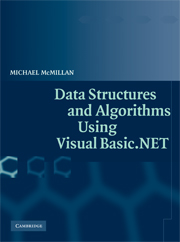Book contents
- Frontmatter
- Contents
- Preface
- Introduction
- Chapter 1 Collections
- Chapter 2 Arrays and ArrayLists
- Chapter 3 Basic Sorting Algorithms
- Chapter 4 Basic Searching Algorithms
- Chapter 5 Stacks and Queues
- Chapter 6 The BitArray Class
- Chapter 7 Strings, the String Class, and the StringBuilder Class
- Chapter 8 Pattern Matching and Text Processing
- Chapter 9 Building Dictionaries: The DictionaryBase Class and the SortedList Class
- Chapter 10 Hashing and the HashTable Class
- Chapter 11 Linked Lists
- Chapter 12 Binary Trees and Binary Search Trees
- Chapter 13 Sets
- Chapter 14 Advanced Sorting Algorithms
- Chapter 15 Advanced Data Structures and Algorithms for Searching
- Chapter 16 Graphs and Graph Algorithms
- Chapter 17 Advanced Algorithms
- References
- Index
Chapter 5 - Stacks and Queues
Published online by Cambridge University Press: 11 August 2009
- Frontmatter
- Contents
- Preface
- Introduction
- Chapter 1 Collections
- Chapter 2 Arrays and ArrayLists
- Chapter 3 Basic Sorting Algorithms
- Chapter 4 Basic Searching Algorithms
- Chapter 5 Stacks and Queues
- Chapter 6 The BitArray Class
- Chapter 7 Strings, the String Class, and the StringBuilder Class
- Chapter 8 Pattern Matching and Text Processing
- Chapter 9 Building Dictionaries: The DictionaryBase Class and the SortedList Class
- Chapter 10 Hashing and the HashTable Class
- Chapter 11 Linked Lists
- Chapter 12 Binary Trees and Binary Search Trees
- Chapter 13 Sets
- Chapter 14 Advanced Sorting Algorithms
- Chapter 15 Advanced Data Structures and Algorithms for Searching
- Chapter 16 Graphs and Graph Algorithms
- Chapter 17 Advanced Algorithms
- References
- Index
Summary
Data organize naturally as lists. We have already used the Array and ArrayList classes for handling data organized as a list. Although those data structures helped us group the data in a convenient form for processing, neither structure provides a real abstraction for actually designing and implementing problem solutions.
Two list-oriented data structures that provide easy-to-understand abstractions are stacks and queues. Data in a stack are added and removed from only one end of the list; data in a queue are added at one end and removed from the other end of a list. Stacks are used extensively in programming language implementations, from everything from expression evaluation to handling function calls. Queues are used to prioritize operating system processes and to simulate events in the real world, such as teller lines at banks and the operation of elevators in buildings.
VB.NET provides two classes for using these data structures: the Stack class and the Queue class. We'll discuss how to use these classes and look at some practical examples in this chapter.
STACKS, A STACK IMPLEMENTATION, AND THE STACK CLASS
The stack is one of the most frequently used data structures, as we just mentioned. We define a stack as a list of items that are accessible only from the end of the list, which is called the top of the stack. The standard model for a stack is a stack of trays at a cafeteria.
- Type
- Chapter
- Information
- Data Structures and Algorithms Using Visual Basic.NET , pp. 99 - 123Publisher: Cambridge University PressPrint publication year: 2005



